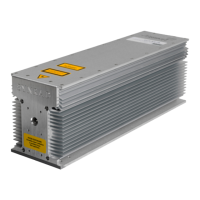technical reference
38
SYNRAD OEM v30 Operator’s Manual Version 2
Technical overview
Focusing optics
When selecting a focusing optic, the primary consideration should be material thickness and any vertical
tolerances that occur during nal part positioning rather than making a selection based only on minimum
spot size. The chosen focal length should create the smallest possible focused spot while providing the
depth of eld required for the material being processed.
Caution
possible
equipment
damage
Any contaminants on the laser’s output window (or on any optic
in the beam path) can absorb enough energy to damage the optic.
Inspect all beam delivery optics periodically for signs of contaminants
and carefully clean as required. In dirty environments, purge laser
optics using ltered air or nitrogen to prevent vapor and debris from
accumulating on optical surfaces.
Optics are fragile and must be handled carefully, preferably by the mounting ring only. Be careful to select
optics that are thick enough to withstand the maximum assist gas pressure available for the process. This is
especially important in metal cutting applications using high-pressure assist gases.
Cleanliness is another important issue aecting performance and becomes increasingly important as laser
power increases. Dirty or scratched lenses will under perform, exhibit a vastly shortened lifetime, and may
fail catastrophically.
When the application requires air (instead of nitrogen) as an assist gas, use only breathing quality air
available in cylinders from a speciality gas supply company. Compressed shop air contains minute par-
ticles of oil and other contaminants that will damage optical surfaces. If compressed shop air is the only
choice available, it must be ltered and dried to ISO 8573-1:2010 Class 1, 2, 1 specications as shown in
the following table.
Table 4-1 Assist gas purity specications
Assist Gas Typical Purpose Specication
Air Cutting/Drilling Breathing Grade > 99.9996% purity; ltered to ISO Class 1
particulate level
Air Cutting/Drilling Compressed Instrument-grade air ltered and dried to
ISO 8573-1:2010 Class 1, 2, 1 (< 10 1.0–
5.0 µm particles/m
3
; < –40 °F dew point;
< 0.01 mg/m
3
oil vapor)
Argon Welding High Purity Grade > 99.998% purity; ltered to ISO Class 1
particulate level
Helium Welding High Purity Grade > 99.997% purity; ltered to ISO Class 1
particulate level
Nitrogen Cutting/Drilling High Purity Grade > 99.9500% purity; ltered to ISO Class 1
particulate level
Oxygen Cutting/Drilling Ultra Pure Grade > 99.9998% purity; ltered to ISO Class 1
particulate level

